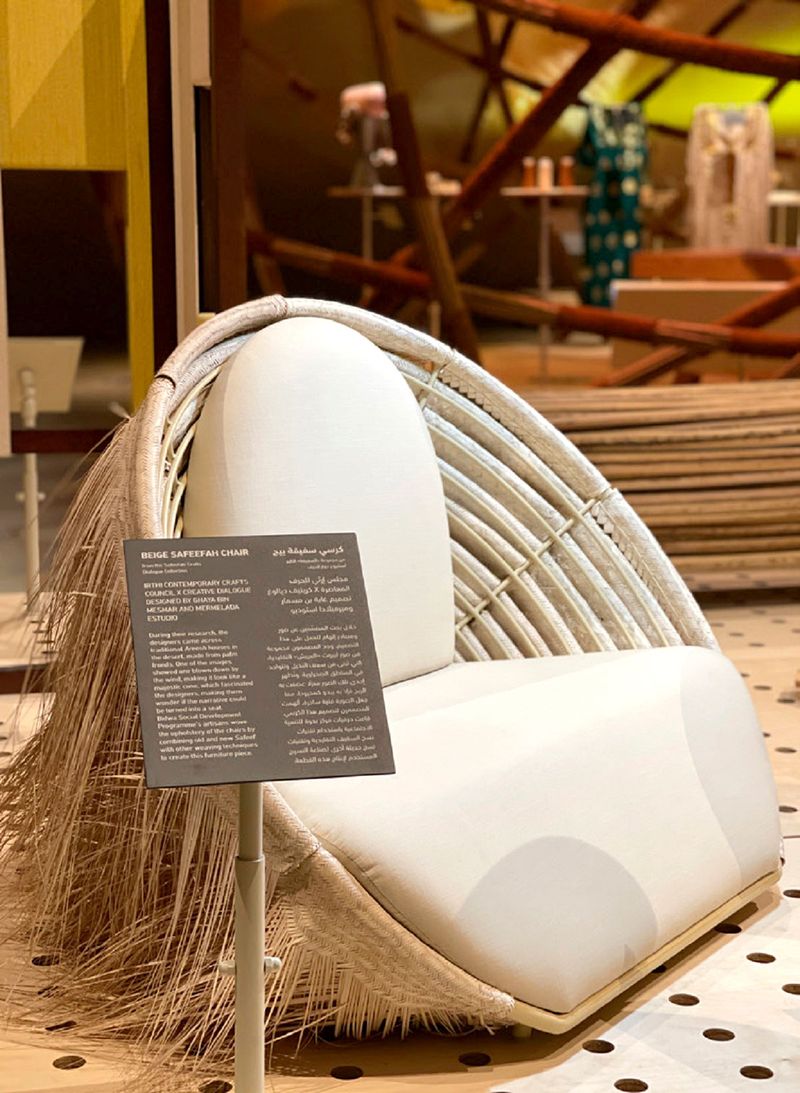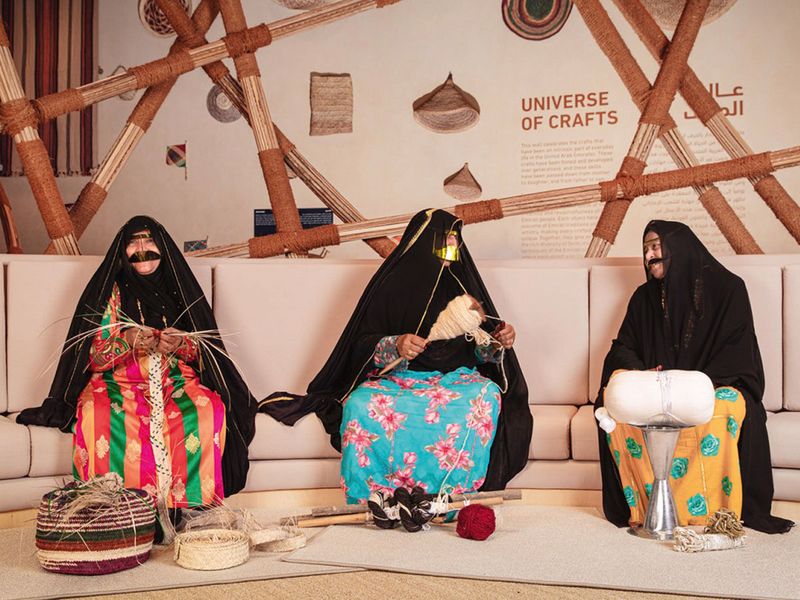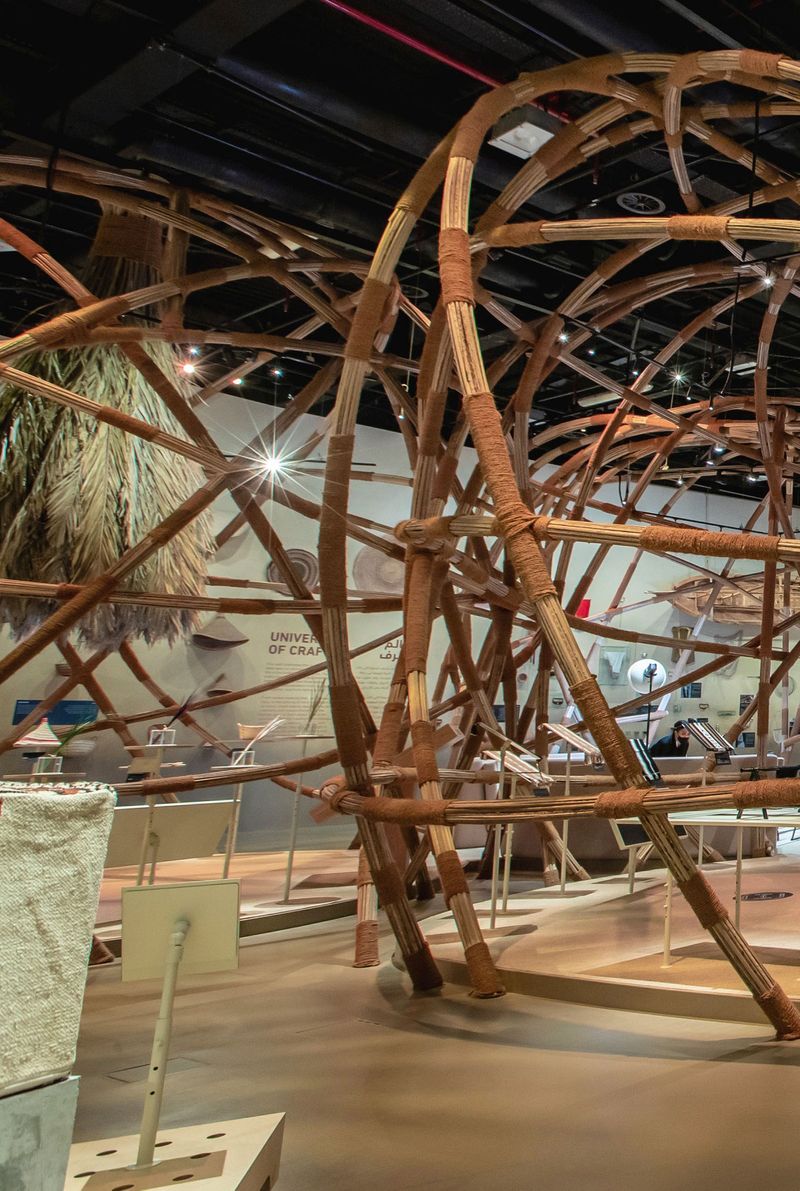
On a crisp Friday afternoon, I set out to explore a cultural gem that sits tidily in the vast expanses of Al Hosn, Abu Dhabi’s original urban block that’s steeped in history. The site is home to the Cultural Foundation and Qasr Al Hosn, which is the oldest living memorial of the city – built around the 1790s, its walls echo riveting stories of the Emirate’s ruling family that it once housed, and centuries-old traditions that are the cornerstone of the UAE.
Located next to it is the House of Artisans, a space filled with quiet charm that shows how the rich past of Emirati craftsmanship offers a vantage point of its present and future. It originally opened its doors in December 2018 and now has a new permanent exhibition on view, which was unveiled in April 2021 when the space was reopened by the Department of Culture and Tourism – Abu Dhabi.
When I stepped inside, I was immediately enraptured by the sharp edit of cultural production, with the whole Emirati aesthetic vocabulary on display. “Wow,” I whispered to myself, as I walked into the setting that offers both a retrospective glance and glimpse into the future of the UAE’s traditional crafts and contemporary art and design.

“The showcase on view before was much simpler than the one you see right now,” said Ayisha Hassan Khansaheb, Senior Researcher at Qasr Al Hosn, who curated the ‘House of Artisans’ exhibition along with other in-house team members.
“It didn’t include contemporary artworks and objects. So, we felt the need to expand our content and make it more creative and innovative,” she added.
Designed by Amsterdam-based Kossmann Dejong studio with Tellart, the exhibition is envisioned as a ‘woven village’, with a stellar facade of woven wicker panels by architect Alex Franklin that immediately draws attention. In the open space that’s flecked with two long curved walls, stand head-turning creations like pavilions woven with palm leaves using the traditional construction technique called Arish, and a large-scale thread spool installation.
With its rich cultural language, the Al Hosn site serves as a fitting location to house an exhibition that nods to both traditional Emirati crafts and contemporary art and design.
“We like to merge them together because the late Sheikh Zayed bin Sultan Al Nahyan was a proponent of progression in arts and crafts,” Ayisha stated. “So, the House of Artisans was launched to document intangible heritage through its exhibition, artisans and retail options.”
The space offers a dialogue across its multiple sections that evoke a multisensorial experience. At the Traditional Crafts Pavilion, which is a reimagined circular majlis, I interacted with vibrant burqa-clad Emirati artisans – they rhythmically wove yarn on a floor loom as part of the Al-Sadu process, braided palm leaves into delicate strips using a traditional technique called Khoos and indulged in decorative Talli embroidery. Then, there’s the Modern Crafts Island.

“We wanted to position the House of Artisans as a hub of crafts – both contemporary and traditional,” shared Ayisha. “We see great interest in contemporary creatives whose work is directly or indirectly inspired by crafts. We started with a mood board and curated a list of designers and artists. We then identified their creations that we wanted to display and also commissioned them to make pieces for us.”
Among the highlights of the contemporary art and design section are the Crossing Coasts shoes by Shaikha Al Ali, which draw inspiration from the UAE’s coast and marine crafts, and the Spun Barrier interior divider by Azza Al Sharif that offers a contemporary take on Al-Sadu partitions.
Also on view are Azza Al Qubaisi’s Yareeda Bench, made with Kurab (wide palm trees), and Roudha Al Shamsi’s Spindle that nods to the process of Al-Sadu weaving. The space showcases the Talli Deconstructed Garments collection by the Irthi Contemporary Crafts Council, which has been designed by Shoug Fardan.
From Rawdha Al Ketbi’s Misnad installation that features woven Al-Sadu cushions embedded in concrete pedestals, to Hessa Al Ajmani’s Elemental Dialogues pottery line, which is inspired by the beauty of the UAE’s native flora and ancient ceramics; to Afra Al Dhaheri’s deeply contemplative My Grandmother Had Time For It display, the showcase reflects on the culmination of the past, present and future.
The House of Artisans’ exhibition also features global collaborations between the Irthi Contemporary Crafts Council and contemporary digital gallery Adorno. Together, they’ve launched the Crafts Dialogue initiative that comprises creations like the Fruit
Bowl by Shaikha Bin Dhaher and Adrian Salvador Candela, which offers a confluence of Emirati Talli and Spanish leather, and the Safeefah chair by Ghaya Bin Mesmar and Mermelada Estudio.
Ayisha shared that sustainability is at the core of the Modern Crafts Island and the overall exhibition journey. “During our research, we discovered how sustainable traditional crafts are. In the past, people were so much more conscious of what they had because they didn’t have as much as we do now,” she noted. “But sustainability has also inspired many contemporary artists and designers because they also prioritize using natural materials and being resourceful. They’re employing innovative methods but also respecting the environment.”

As I perused the exhibition, I came across the Universe of Crafts, an archival wall that comprises over 60 historic objects that have either been created by artisans or sourced from people within the community, including a burqa that belonged to a woman in the early 1900s.
“Each of these objects tells a story. You can just stand in front of this wall and imagine the stories of all the people who lived in the UAE at such an important time,” said Ayisha. “The idea is that these sections will keep changing and we’ll be adding more objects to them that we’ll eventually acquire.”
And then, I rounded off my experience with a visit to the majlis-style Bait Al Gahwa with its delicious aroma of fresh coffee beans, where I savoured the traditional preparation and presentation of Arabic coffee or Gahwa. At the heart of the House of Artisans experience is to converge traditional and contemporary creations to satiate the palate of visitors across generations.
“We believe that traditions and cultures shift and evolve with time, and we have to be at the forefront of this change. At Al Hosn Festival in 2019, we had a collaboration where Nike sneakers were deconstructed and reconstructed using camel leather, and Al-Sadu and Talli designs. It shifted people’s understanding of sneaker culture and how it can be adapted to represent the crafts of the UAE,” Ayisha shared. As an extension of these efforts, the House of Artisans offers customised products at the Al Hosn retail store.
“200 years ago, Al-Sadu was used to create Bedouin tents in the middle of the desert. Now, we use it for sneakers, belts and dresses. We also have a collection called Nomad, which includes weekender bags, sneakers and sandals. We’re emphasising that crafts don’t have to be so rigid. We can still be authentic to the technique and make something contemporary that can be utilized today,” noted Ayisha. “We also plan on eventually selling these items online through the Abu Dhabi cultural platform and Amazon.”
At House of Artisans, efforts are currently under way to launch an interactive year-round program for the community. “We plan on hosting workshops from January 2022, and we also have exciting projects that are still in their early stages. We’re looking to do more collaborations and add new pieces to the exhibition. So, I encourage people to visit us regularly and keep checking our website,” stated Ayisha.
As I soaked up this immersive experience at the House of Artisans, I vowed to return soon with a renewed appreciation of crafts that continue to make our homes more human.


